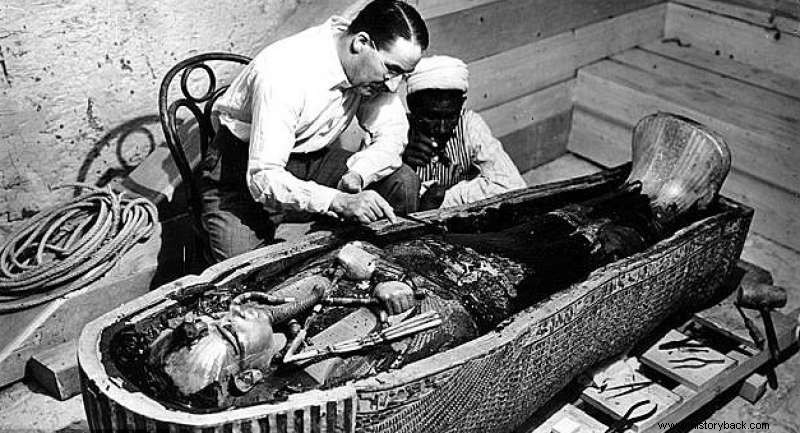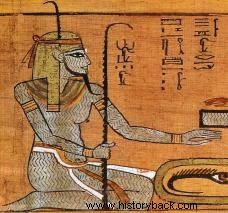Almost 100 years have passed from the discovery of his tomb by the British Egyptologist Howard Carter .
Tutankhamun continues today to keep the attention of the researchers high not only because of the intact funerary collection that surrounded him, found in his tomb despite his early death and his short reign, but also because of the mystery that surrounded the his life, death and lineage.

Archaeologists still wonder who the real Tutankhamun was . He was the son or brother of the monotheist Pharaoh Akhenaten ? Why did his tomb contain so many treasures, even though he died so young? How did he die? Was he killed at 19 or did he suffer from some disease?
In 2005 some of these mysteries were solved when Tutankhamun's mummy was subjected to a CT scan , to an intense medical check-up and forensic analysis that were the most complete since his discovery.
The tests lasted 5 years and in 2010 1,700 images were published of high-resolution scans.
The Egyptian science team concluded that the boy king had died of natural causes at the age of 19 and had not been killed by a blow to the back of the head as traditionally believed.
Not traces of violence were discovered.
The team theorized that the open fracture in the back of the mummy's head it was probably used as a second way through which the embalming liquid was introduced into the cranial cavity.
At the same time the scans revealed a fracture above the left knee which may have occurred a day or two before the pharaoh's death, suggesting that Tutankhamun he may have died of infection.
With the help of German medical anthropologists, the Egyptian scientific team claimed that the real causes of Tutankhamun's death were malaria and other pathogens . The team concluded that a sudden fracture of the leg could have led to a life-threatening condition when the malaria infection occurred.
DNA tests also showed that Akhenaten was Tutankhamun's father. , not his brother, as some have claimed.
The paleogeneticist Carsten Pusch of the University of Tubingen in Germany , who was part of the scientific group, described Tutankhamun as "not a proud pharaoh or a strong leader since he was a fragile and weak boy ". “He could not walk alone and needed other people or sticks due to bone necrosis “, Said Pusch .
Scientific tests on other 11 mummies carried out simultaneously revealed that the family of Tutankhamun was plagued by malformations and infections.

Tutankhamon was diagnosed with various pathologies and in other 4 mummies of his family. Among these is the Kohler II disease , a painful foot pathology affecting II and the III metatarsus .
The Executive Director of Cairo-Scan Center, Ashraf Selim, claimed that the scans revealed that Tutankhamun he was also suffering from osteonecrosis , a condition in which a reduced blood supply to the bone leads to severe weakening or destruction of the tissues. “This may have made Tutankhamun particularly vulnerable to physical injuries and may have been the cause of the altered structure of the left foot “, Said Selim .

The results provide an answer as to why 130 walking sticks were found inside his tomb and because he is shown in several portraits shooting arrows while sitting.
Working independently, French teams , American and Egyptian they used the most innovative forensic techniques to reconstruct the Pharaoh's facial features.
And they reached surprisingly similar conclusions .
The results revealed a distinctly different face from the image on the golden mask, as well as from many of his statues.
In 2014 a new virtual autopsy is conducted on the young pharaoh and shown in a BBC documentary titled “ Tutankhamun :The Truth Uncovered “.

Scientists in the documentary claim to have recreated the first life-size image Tutankhamun through 2,000 scans computed tomography.
They built a computer model in 3D how it would be during his lifetime. The result is shocking, with scientists claiming Tutankhamun had a clubfoot and female hips. The research also states that the parents were likely brother and sister, which led to a child full of genetic disorders.
“It would not have been possible for him to drive a wagon, especially with his foot, as he was not able to stand alone ", says Albert Zink, Director of the Institute for mummies and the Iceman at EURAC in Bolzano .
Such claims sparked the anger of Egyptian Egyptologists , who described it as "a malicious slander against the ancient Egyptian civilization".
Hawass claims that such speculations are scientifically unfounded, pure invention. "We know that this man had 130 walking sticks and that he shot arrows while sitting, but that doesn't mean he had a clubfoot, "he said.

Egyptologist Ahmed Saleh refused to accept Zink 's results .
he Claims that Tutankhamun's mother , most likely a woman named Kia , she was not the sister of Akhenaten and she wasn't even a relative of him.
Ahmed Said , professor of ancient Egyptian civilization at the Faculty of Archeology of the University of Cairo , said research conducted since 2005 at 2010 they have no correlation with results projected in 2014 in the BBC documentary . Brother-sister marriage was not evidence of genetic disorders as it was a common trend in the ancient Egyptian royal family and was intended to preserve the purity of royal blood. Also, Tutankhamun's large hips and the apparently feminine aspect of him belonged to an artistic style used to represent the god of the Nile Hapy . It was an iconographic convention which had no relation to the Pharaoh's royal appearance.

